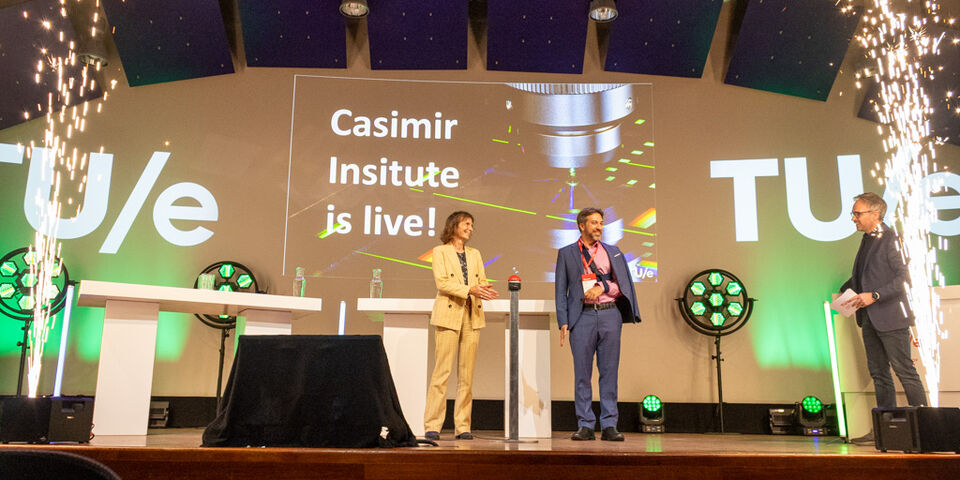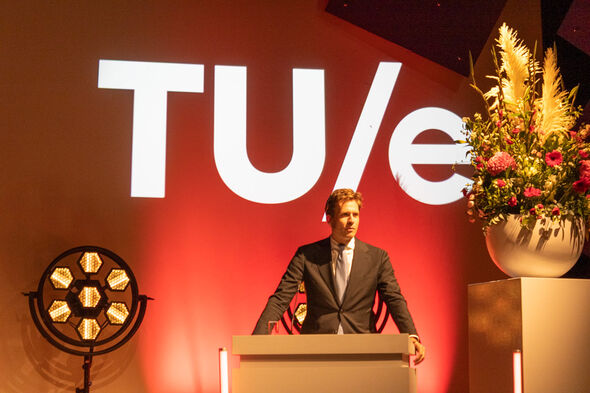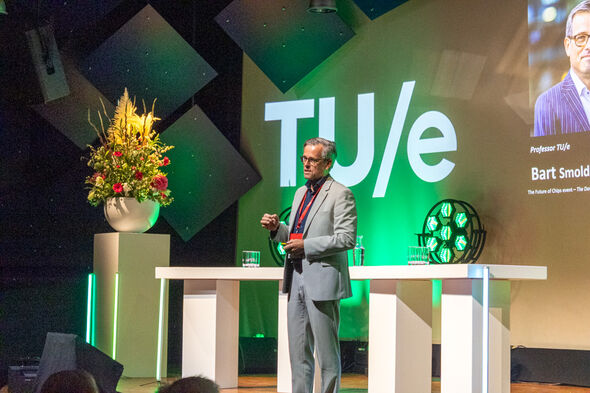TU/e launches Casimir Institute with focus on semiconductors
TU/e launches the Casimir Institute a new university-wide institute focused on research into semiconductors, advanced materials, and high-tech systems. Scientific director Bart Smolders: “Our ambition is to become Europe’s leading chip university.”
The widely shared message was that the Netherlands and Europe must become global leaders in semiconductors. To keep innovating, however, scientists need to collaborate more across disciplines and work more closely with the chip industry. With that in mind, TU/e launched the Casimir Institute Tuesday. It is named after Hendrik Casimir, one of the founding figures of the Dutch chip and high-tech industry.
Merger
The Eindhoven Hendrik Casimir Institute, the High Tech Systems Center, and the Future Chips Flagship will merge into the new institute and cease to exist as separate entities. The university emphasizes that no forced layoffs will take place as part of the merger. To meet the Beethoven objectives, more researchers and support staff need to be hired: 146 new scientists (who will supervise around 500 PhD candidates) and 146 support staff members by 2030.
More than seven hundred researchers will collaborate across disciplines in the new institute on semiconductors, quantum technology, photonics, advanced materials, processes, and high-tech systems. The institute will be led by managing director Victor Sanchez Martin and scientific director Bart Smolders (see interview with Smolders at the end of this article).
Ecosystem
The afternoon program opened with remarks by Mayor Jeroen Dijsselbloem, who emphasized the institute’s regional significance. He expressed his hope that it will create greater synergy between industry and science. “The region’s current success is thanks to close collaboration between researchers and industry. This institute will help accelerate the innovation process.”
Minister Karremans of Economic Affairs spoke next. He stressed the importance of the institute in strengthening both the national and European competitive position in semicon. The new institute is also intended to make the Dutch and European chip market less dependent on countries outside the EU, such as the United States and China. Yesterday, Karremans announced a semicon coalition initiated by the Netherlands, now supported by 27 EU member states.
“Technological developments are advancing faster than the curricula at universities of applied sciences and research universities,” said Karremans. “With this institute, education and developments in industry will be better aligned. It directly addresses the barrier between those two worlds. You need to see it as a single ecosystem.”
Interview with scientific director Bart Smolders
“The chip world is changing,” says scientific director Bart Smolders. He previously led the Future Chips Flagship and worked at NXP for many years. “The industry is becoming broader and more complex. It’s getting harder to keep track of all the different subfields. That’s why it’s important for this institute to focus on three research themes: semiconductors, advanced materials, and high-tech systems.”
These themes were defined after discussions with TU/e scientists and industry representatives. “We all agree that these three disciplines belong together. Scientists and future students need to build connections between these areas in order to achieve breakthroughs.”
The new institute will support this in several ways. On the one hand, by strengthening interdisciplinary collaboration within TU/e. On the other, by contributing to research and funding proposals at both national and European levels. “By clustering seven hundred researchers, you increase visibility and can exert more strategic influence on new initiatives.”
Beethoven
The new institute also responds to national and international developments, in which both the Netherlands and Europe aim to strengthen their global competitive position in semiconductors. In that context, the government announced a multi-billion-euro boost last year, under the name project Beethoven. The program is intended to support the growth of key players like NXP and ASML and their supply chains, particularly in the areas of infrastructure, housing, and talent. TU/e will receive 91 million euros in phases until 2030, designated to train more technical talent and facilitate research.
“The four departments (red: Electrical Engineering, Applied Physics, Mathematics and Computer Science, and Mechanical Engineering) will hire many scientists and support staff for this purpose. As an institute, we keep track of the bigger picture and identify which expertise is missing so that we can recruit in a targeted way. That process is ongoing.” The yet-to-be-built laboratory building and clean room will also fall under the institute.
At the same time, discussions are taking place across the university about how to shape the research that needs to be conducted. “We’ll formally approach the departments to see if they can contribute to the new institute. They will also be able to use the new facilities. These will be open labs. We want to be as inclusive as possible, while maintaining our focus on semicon.”
Not an ASML university
With the institute, the university hopes to collaborate more strategically with ASML and other Brainport companies. Still, this is not a step toward becoming an ASML university. “That would mean focusing purely on equipment. That’s what ASML does. Instead, we’ve defined three domains. In addition, there are the foundation technologies, which means more out-of-the-box thinking. In the future, for example, we want to combine photonics with electronics, and later with quantum.”
Smolders also emphasizes that the new institute should foster new global players. “We don’t see enough startups in the semiconductor sector in the Netherlands yet. We’re going to train many new young people, and within the Master’s tracks we want to encourage them to start their own companies. It would be wonderful if, twenty years from now, we can look back and say: this initiative gave rise to two new ASMLs.”
This article was translated using AI-assisted tools and reviewed by an editor.





Discussion